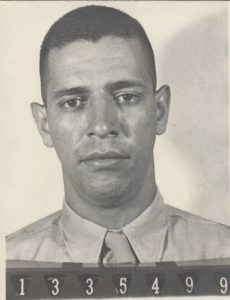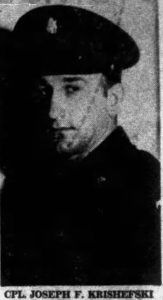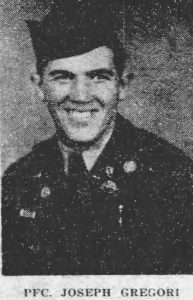James Edward Swainbank, age 29, from Pennsylvania, Luzerne county.
Service era: Korea
Date of death: Wednesday, November 29, 1950
Death details: On November 29, 1950, men from Company G of the U.S. 1st Marine Regiment, MP Company and Tank Company, 1st Marine Division, Company B and elements of Company D of the 31st Infantry Regiment, Headquarters Company of the X Corps, and Royal Marines from Number 41 Independent Commando Battalion were sent north from Koto-ri to open the main supply route to Hagaru-ri and resupply and reinforce Allied troops that had been surrounded near the Chosin Reservoir. The group, known as Task Force Drysdale, set out with tanks and other vehicles in the lead and rear, and initially only met light resistance from Chinese Communist Forces (CCF). As attacks increased in ferocity, the group became fragmented as the CCF managed to establish road blocks that further split the task force. Soon, the CCF blew a bridge and halted the convoy altogether. The Royal Marines and most of Company G were north of the bridge at this time and were able to continue to Hagaru-ri. Near the south end of the convoy, a destroyed truck blocked the road. The tanks and troops south of the destroyed truck fought as long as possible before ultimately returning to Koto-ri on November 30. The men between the blown bridge and the destroyed truck, however, were trapped, and subjected to several mortar barrages before CCF moved into hand-to-hand combat range. Fighting raged there until the morning of November 30, when the survivors were forced to surrender. Over 300 troops were wounded, captured, or died during the action. Sergeant James Edward Swainbank, who joined the U.S. Army from Pennsylvania, was a member of B Company, 1st Battalion, 31st Infantry Regiment, 7th Infantry Division. He went missing in action on November 29, 1950, during Task Force Drysdale?s advance to Hagaru-ri. Information from a repatriated POW indicated that Sergeant Swainbank was actually killed in action on November 29 and the Army so amended his status. His remains could not be recovered, and he has not been identified among remains returned to U.S. custody after the war. Today, Sergeant Swainbank is memorialized on the Courts of the Missing at the National Memorial Cemetery of the Pacific.
Source: National Archives, Defense POW/MIA Accounting Agency


 Death details: In late March 1953, elements of the 1st Marine Division manned a string of outposts along a 33-mile section of the main line of resistance on the Korean Peninsula, near the present-day Demilitarized Zone (DMZ). The 1st Marine Division’s 5th Marine Regiment was responsible for three of these outposts, named Carson, Reno, and Vegas, or collectively “the Nevada Cities Complex.” On March 26, Chinese Communist Forces attacked all three outposts. Although Carson managed to stave off the assault, Reno and Vegas, which were more lightly manned, eventually succumbed to the enemy. Over 1,000 Marines were killed, wounded, or went missing during the attack on the Nevada Cities Complex. Private First Class Salvadore Dominic Kinney joined the U.S. Marine Corps from Pennsylvania and was a member of A Company, 1st Battalion, 5th Marine Regiment, 1st Marine Division. He went missing in action during the fighting at the Nevada Cities Complex on March 26, 1953. He was never reported to be a prisoner of war, and he was not identified among remains returned to U.S. custody after the conflict’s ceasefire. Today, Private First Class Kinney is memorialized on the Courts of the Missing at the National Memorial Cemetery of the Pacific.
Death details: In late March 1953, elements of the 1st Marine Division manned a string of outposts along a 33-mile section of the main line of resistance on the Korean Peninsula, near the present-day Demilitarized Zone (DMZ). The 1st Marine Division’s 5th Marine Regiment was responsible for three of these outposts, named Carson, Reno, and Vegas, or collectively “the Nevada Cities Complex.” On March 26, Chinese Communist Forces attacked all three outposts. Although Carson managed to stave off the assault, Reno and Vegas, which were more lightly manned, eventually succumbed to the enemy. Over 1,000 Marines were killed, wounded, or went missing during the attack on the Nevada Cities Complex. Private First Class Salvadore Dominic Kinney joined the U.S. Marine Corps from Pennsylvania and was a member of A Company, 1st Battalion, 5th Marine Regiment, 1st Marine Division. He went missing in action during the fighting at the Nevada Cities Complex on March 26, 1953. He was never reported to be a prisoner of war, and he was not identified among remains returned to U.S. custody after the conflict’s ceasefire. Today, Private First Class Kinney is memorialized on the Courts of the Missing at the National Memorial Cemetery of the Pacific.

